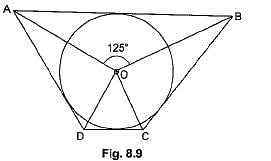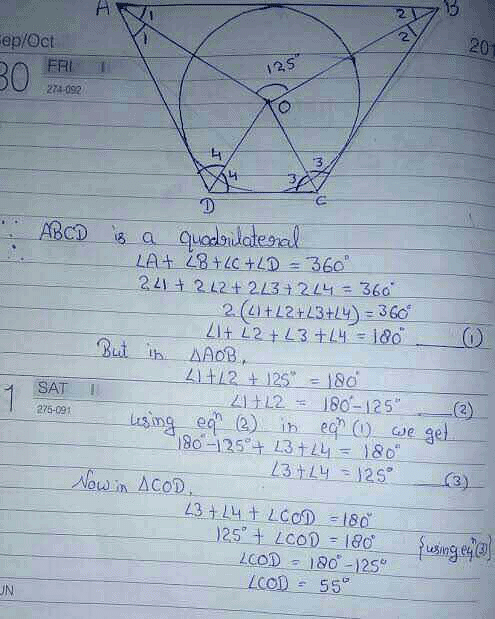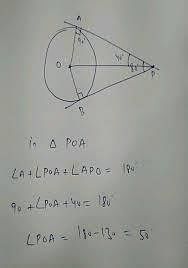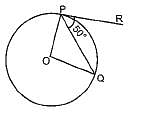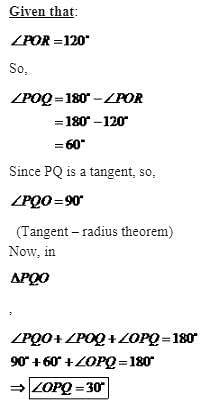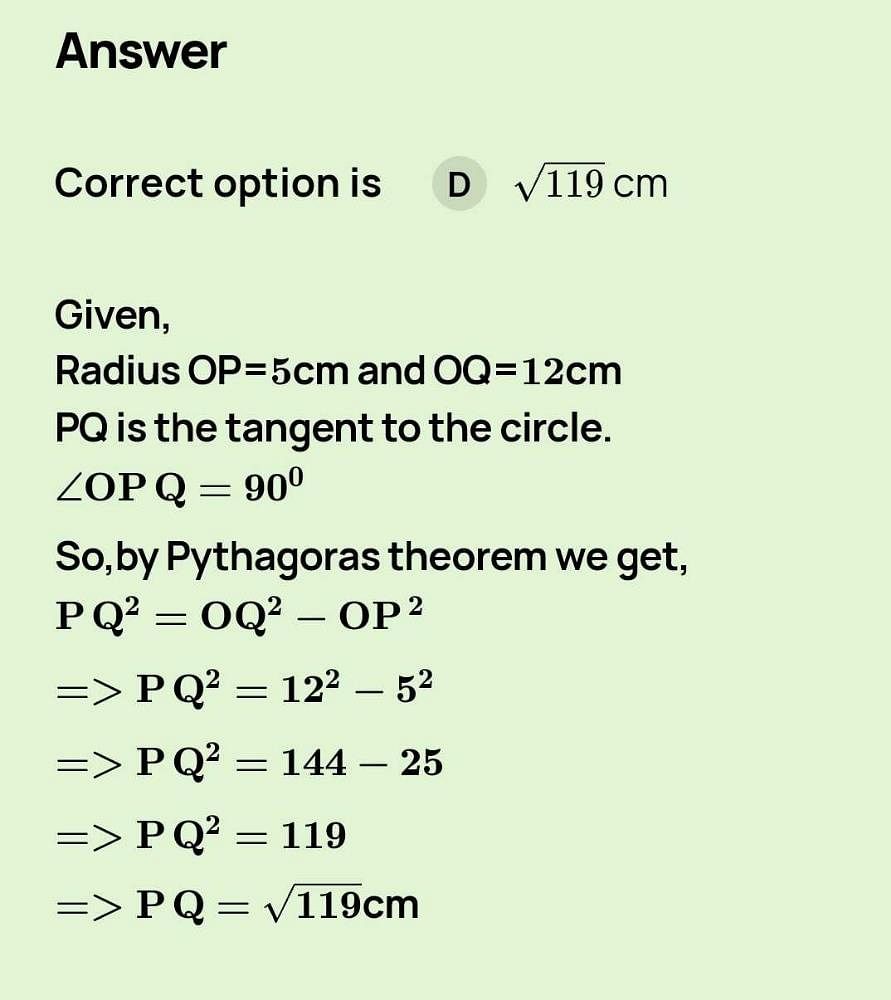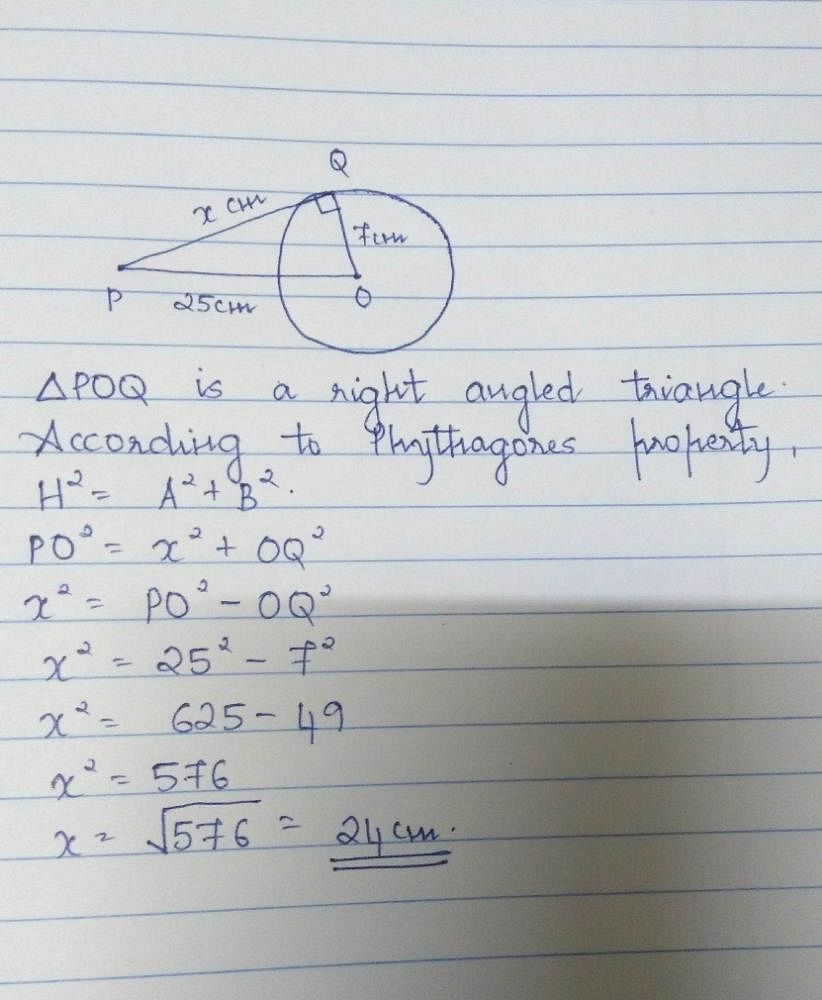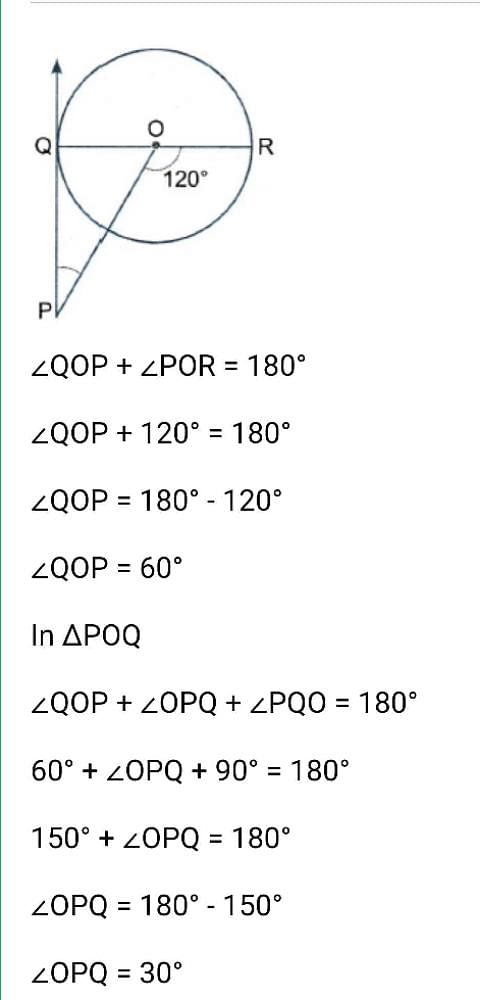All Exams >
Year 10 >
Mathematics for Year 10 >
All Questions
All questions of Circles for Year 10 Exam
In Fig. 8.5, PQ is a chord of a circle and PT is the tangent at P such that ∠QPT = 60°. Then ∠PRQ is equal to
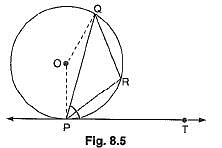
- a)135°
- b)150°
- c)120°
- d)110°
Correct answer is option 'C'. Can you explain this answer?
In Fig. 8.5, PQ is a chord of a circle and PT is the tangent at P such that ∠QPT = 60°. Then ∠PRQ is equal to


a)
135°
b)
150°
c)
120°
d)
110°

|
Drishti Kumari answered |
Angle QPT = 60 degree
Angle OPT = 90 degree
Angle OPQ = 90 - 60 = 30 degree
OP & OQ are same ( radius of circle )
Therefore Angle OPQ = OQP ( Equal opposite side make equal opposite angle )
POQ + OPQ + OQP = 180 ( Angle sum property )
Angle POQ + 30 + 30 = 180
Angle POQ = 180 - 60
Angle POQ = 120 degree
Angle POQ = Angle PRQ
So, Angle PRQ = 120 degree
That's why option (C) is correct .
| 1 Crore+ students have signed up on EduRev. Have you? Download the App |
In the given figure, there are two circles with the centres O and O' touching each other internally at P. Tangents TQ and TP are drawn to the larger circle and tangents TP and TR are drawn to the smaller circle. Find TQ : TR
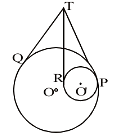
- a)8 : 7
- b)7 : 8
- c)5 : 4
- d)1 : 1
Correct answer is option 'D'. Can you explain this answer?
In the given figure, there are two circles with the centres O and O' touching each other internally at P. Tangents TQ and TP are drawn to the larger circle and tangents TP and TR are drawn to the smaller circle. Find TQ : TR
a)
8 : 7
b)
7 : 8
c)
5 : 4
d)
1 : 1
|
|
Nishta Shakya answered |
Tangents drawn from a external point to the circle are equal .
i.e. TQ = TP (for large circle)
Again TR = TP
Then we take the ratios
TQ/TR
=> TP/TP
=>1/1
So the ratio is 1:1
Hope it works
Thanks
i.e. TQ = TP (for large circle)
Again TR = TP
Then we take the ratios
TQ/TR
=> TP/TP
=>1/1
So the ratio is 1:1
Hope it works
Thanks
A circle can pass through
- a)2 collinear points
- b)3 collinear points
- c)4 collinear points
- d)4 collinear points
Correct answer is option 'A'. Can you explain this answer?
A circle can pass through
a)
2 collinear points
b)
3 collinear points
c)
4 collinear points
d)
4 collinear points
|
|
Krishna Iyer answered |
The answer can be 2 collinear points as well. We have three collinear points. Join one point to the other two points and then draw the perpendicular bisector for both the lines
Join the perpendicular bisectors. The point is the centre of the circle. And a circle can be formed then. Also two points can form a circle as the two points joines becomes a diameter.
Join the perpendicular bisectors. The point is the centre of the circle. And a circle can be formed then. Also two points can form a circle as the two points joines becomes a diameter.
Option D : The number of circles which can pass through three given non-collinear points is exactly one.
So, A is the correct Option
In the given figure, PQ is the tangent of the circle. Line segment PR intersects the circle at Nand R. PQ = 15 cm, PR = 25 cm, find PN: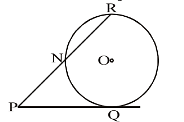
- a)15 cm
- b)10 cm
- c)9 cm
- d)6 cm
Correct answer is option 'C'. Can you explain this answer?
In the given figure, PQ is the tangent of the circle. Line segment PR intersects the circle at Nand R. PQ = 15 cm, PR = 25 cm, find PN:
a)
15 cm
b)
10 cm
c)
9 cm
d)
6 cm
|
|
Archana singh answered |
Given, PQ = 15 cm
PR = 25 cm
We know that, PQ² = PN × PR
15² = PN × 25
225 = PN × 25
PN = 9
15² = PN × 25
225 = PN × 25
PN = 9
A circle touches x-axis at A and y-axis at B. If O is origin and OA = 5 units, then diameter of the circle is- a)8 units
- b)10 units
- c)

- d)

Correct answer is option 'B'. Can you explain this answer?
A circle touches x-axis at A and y-axis at B. If O is origin and OA = 5 units, then diameter of the circle is
a)
8 units
b)
10 units
c)

d)

|
|
Amit Sharma answered |
OA = OB ⇒ OB = 5
AC = BC [Radii]
⇒ OACB is a square.
⇒ AC = OA = 5
⇒ Diameter =10 units.
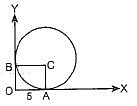
AC = BC [Radii]
⇒ OACB is a square.
⇒ AC = OA = 5
⇒ Diameter =10 units.

In the given figure, PAQ is the tangent. BC is the diameter of the circle. m ∠BAQ = 60°, find m ∠ABC :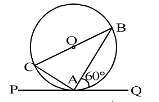
- a)25°
- b)30°
- c)45°
- d)60°
Correct answer is option 'B'. Can you explain this answer?
In the given figure, PAQ is the tangent. BC is the diameter of the circle. m ∠BAQ = 60°, find m ∠ABC :
a)
25°
b)
30°
c)
45°
d)
60°
|
|
Rohit Sharma answered |
The correct answer is b
∠ABC = 30 degrees
If figure 1, O is the centre of a circle, PQ is a chord and PT is the tangent at P. If ∠POQ = 70o, then ∠TPQ is equal to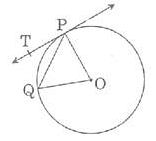
- a)45°
- b)5°
- c)35°
- d)70°
Correct answer is 'C'. Can you explain this answer?
If figure 1, O is the centre of a circle, PQ is a chord and PT is the tangent at P. If ∠POQ = 70o, then ∠TPQ is equal to
a)
45°
b)
5°
c)
35°
d)
70°
|
|
Ananya Das answered |
POQ is an isosceles triangle because of 2 radii as sides. So by angle sum property, 2*angle OPQ=180-70=110
Angle OPQ=55°
Since Angle TPO is a right angle , because PT is a tangent,
Angle OPQ+Angle TPQ=90
Angle TPQ=90° - 55° = 35°
Angle OPQ=55°
Since Angle TPO is a right angle , because PT is a tangent,
Angle OPQ+Angle TPQ=90
Angle TPQ=90° - 55° = 35°
In the given figure, PA and PB are tangents from P to a circle with centre O. If ∠AOB = 130°, then find ∠APB.- a)40°
- b) 55°
- c)50°
- d)60°
Correct answer is option 'C'. Can you explain this answer?
In the given figure, PA and PB are tangents from P to a circle with centre O. If ∠AOB = 130°, then find ∠APB.
a)
40°
b)
55°
c)
50°
d)
60°
|
|
Rohit Sharma answered |
In AOB, by angle sum property
Angle A + Angle B + Angle O=180°
2Angle A = 50° (Triangle is isosceles triangle)
Angle A = 25°
We know Angle APB= 2Angle A
Angle APB=2*25= 50°
Angle A + Angle B + Angle O=180°
2Angle A = 50° (Triangle is isosceles triangle)
Angle A = 25°
We know Angle APB= 2Angle A
Angle APB=2*25= 50°
In fig., two circles with centres A and B touch each other externally at k. The length of PQ (in cm) is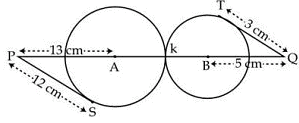
- a)24 cm
- b)20 cm
- c)27 cm
- d)18 cm
Correct answer is option 'C'. Can you explain this answer?
In fig., two circles with centres A and B touch each other externally at k. The length of PQ (in cm) is
a)
24 cm
b)
20 cm
c)
27 cm
d)
18 cm
|
|
Vikas Kumar answered |
Constructions - join AS and join BT.
Case 1 (triangle ASP)
We know, ∠ASP = 900 (radius is perpendicular to tangent at point of contact)
So, in triangle ASP,
AP2 = PS2 + AS2
=> 132 = 122 + AS2
=> 169 = 144 + AS2
+> AS2 = 169 - 144 = 25
=> AS = √25 = 5cm
Since AS is radius, AP = Ak = 5 cm.
Case 2 (triangle BTQ)
We know, ∠BTQ = 900 (radius is perpendicular to tangent at point of contact)
So, in triangle BTQ,
BQ2 = QT2 + BT2
= 52 = 32 + BT2
=> 25 = 9 + BT2
=> BT2 = 25 - 9 = 9
=> BT = √16 = 4cm
Since BT is radius, BT = Bk 4cm
Now, PQ = AP + Ak + Bk + BQ
=> PQ = 13 + 5 + 4 + 5
=> PQ = 27 cm
From a point P which is at a distance of 13 cm from the centre O of a circle of radius 5 cm, the pair of tangents PQ and PR to the circle are drawn. Then the area of the quadrilateral PQOR is- a)60 cm2
- b)65 cm2
- c)30 cm2
- d)32.5 cm2
Correct answer is option 'A'. Can you explain this answer?
From a point P which is at a distance of 13 cm from the centre O of a circle of radius 5 cm, the pair of tangents PQ and PR to the circle are drawn. Then the area of the quadrilateral PQOR is
a)
60 cm2
b)
65 cm2
c)
30 cm2
d)
32.5 cm2
|
|
Krishna Iyer answered |
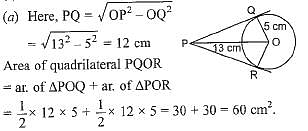
In figure AT is a tangent to the circle with centre O such that OT = 4 cm and ∠OTA = 30°. Then AT is equal to

- a)4 cm
- b)2 cm
- c)2√3 cm
- d)4√3 cm
Correct answer is option 'C'. Can you explain this answer?
In figure AT is a tangent to the circle with centre O such that OT = 4 cm and ∠OTA = 30°. Then AT is equal to


a)
4 cm
b)
2 cm
c)
2√3 cm
d)
4√3 cm
|
|
Gaurav Kumar answered |

∠OAT = 90° [∵ Tangent and radius are ⊥ to each other at the point of contact
In right-angle ΔOAT

If PA and PB are tangents to the circle with centre O such that ∠APB = 40∘, then ∠OAB is equal to
- a)30∘
- b)40∘
- c)25∘
- d)20∘
Correct answer is option 'D'. Can you explain this answer?
If PA and PB are tangents to the circle with centre O such that ∠APB = 40∘, then ∠OAB is equal to
a)
30∘
b)
40∘
c)
25∘
d)
20∘

|
Parth Basu answered |
Let ∠OAB = ∠OBA = x [Opposite angles of opposite equal radii] And ∠AOB =180° - 40° = 140°
Now, in triangle AOB,
∠OAB + ∠OBA + ∠AOB = 180°
⇒ x + x +140° = 180°
⇒ 2x = 40°
⇒ x = 20°
∴ ∠OAB = 20°
Now, in triangle AOB,
∠OAB + ∠OBA + ∠AOB = 180°
⇒ x + x +140° = 180°
⇒ 2x = 40°
⇒ x = 20°
∴ ∠OAB = 20°
Two parallel lines touch the circle at points A and B respectively, If area of the circle is 25πcm2, then AB is equal to- a)5 cm
- b)8 cm
- c)10 cm
- d)25 cm
Correct answer is option 'C'. Can you explain this answer?
Two parallel lines touch the circle at points A and B respectively, If area of the circle is 25πcm2, then AB is equal to
a)
5 cm
b)
8 cm
c)
10 cm
d)
25 cm
|
|
Vivek Rana answered |
Let radius of circle = R
∴ πR2 = 25π
⇒ R = 5cm
∴ Distance between two parallel tangents
= diameter = 2 x 5 = 10 cm.
∴ πR2 = 25π
⇒ R = 5cm
∴ Distance between two parallel tangents
= diameter = 2 x 5 = 10 cm.
At point A on a diameter AB of a circle of radius 10 cm, tangent XAY is drawn to the circle. The length of the chord CD parallel to XY at a distance 16 cm from A is- a)8 cm
- b)10 cm
- c)16 cm
- d)18 cm
Correct answer is option 'C'. Can you explain this answer?
At point A on a diameter AB of a circle of radius 10 cm, tangent XAY is drawn to the circle. The length of the chord CD parallel to XY at a distance 16 cm from A is
a)
8 cm
b)
10 cm
c)
16 cm
d)
18 cm
|
|
Aditya Shah answered |
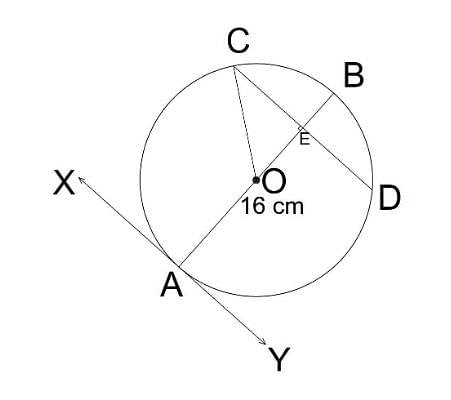
In the given figure
XY is the tangent to the circle
We know that tangent is at right angle with the line joining the tangent point to the centre of the circle
Therefore,
∠OAY = 90°
∵ CD is parallel to XY
Therefore,
∠OAY = ∠BED = 90° (Corresponding angles)
Again,
Given that
AE = 16 cm
And the radius of the circle is 10 cm
Therefore,
AO = 10 cm
∴ OE = AE - AO = 16 - 10 = 6 cm
Also,
OC = 10 cm (Radius of the circle)
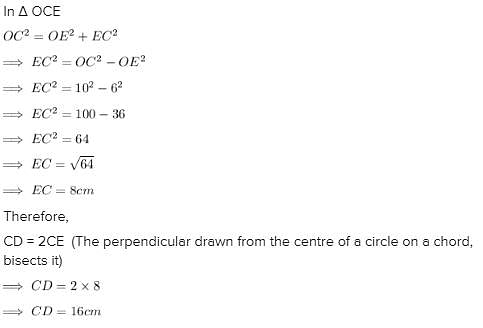
A circle may have…….- a)2 tangent
- b)1 tangent
- c)Infinite tangents
- d)No tangent
Correct answer is option 'C'. Can you explain this answer?
A circle may have…….
a)
2 tangent
b)
1 tangent
c)
Infinite tangents
d)
No tangent
|
|
Vedashree V answered |
Because a tangent intersect only one point on circle so it can form infinite tangents
A tangent PA is drawn from an external point P to a circle of radius 3√2 cm such that the distance of the point P from O is 6 cm as shown figure. The value of ∠APO is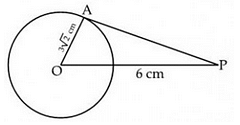
- a)30°
- b)60°
- c)45°
- d)75°
Correct answer is option 'C'. Can you explain this answer?
A tangent PA is drawn from an external point P to a circle of radius 3√2 cm such that the distance of the point P from O is 6 cm as shown figure. The value of ∠APO is
a)
30°
b)
60°
c)
45°
d)
75°
|
|
Pooja Shah answered |
The correct answer is c
In right angled triangle, OAP
sin of angle APO = AO/OP = 1/root2
sin 45 = 1/root2
angle APO = 45 degree
The length of the tangent drawn from a point 8 cm away from the centre of a circle of radius 6 cm is- a)√7 cm
- b)2√7 cm
- c)10 cm
- d)5 cm
Correct answer is option 'B'. Can you explain this answer?
The length of the tangent drawn from a point 8 cm away from the centre of a circle of radius 6 cm is
a)
√7 cm
b)
2√7 cm
c)
10 cm
d)
5 cm
|
|
Pooja Shah answered |
Let P be the external point and PA and PB be the tangents and OA and OB be the radii.
So OP is the hypotenuse=8cm
Applying Pythagoras theorem,
H2 = P2 + B2
64 = AP2 + 36
AP =
So OP is the hypotenuse=8cm
Applying Pythagoras theorem,
H2 = P2 + B2
64 = AP2 + 36
AP =

In the given figure, AR=5cm, BR=4cm and AC =11cm. What is the length of BC?
- a)6 cm
- b)10 cm
- c)4 cm
- d)8 cm
Correct answer is option 'B'. Can you explain this answer?
In the given figure, AR=5cm, BR=4cm and AC =11cm. What is the length of BC?
a)
6 cm
b)
10 cm
c)
4 cm
d)
8 cm
|
|
Vivek Rana answered |
Since the sides of the triangles are tangent to the circle. BR = BP,AR = AQ and CP = CQ
So, BP = 4cm and AQ = 5
CQ = 11-5 = 6 = CP
BC = BP + CP = 4 + 6 = 10 cm
So, BP = 4cm and AQ = 5
CQ = 11-5 = 6 = CP
BC = BP + CP = 4 + 6 = 10 cm
A circle is inscribed in ΔABC having sides 8 cm, 10 cm and 12 cm as shown in the figure. Then,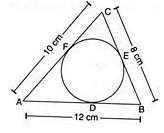
- a)AD = 7 cm, BE = 5 cm.
- b)AD = 8 cm, BE = 5 cm.
- c)AD = 8 cm, BE = 6 cm.
- d)AD = 5 cm, BE = 7 cm.
Correct answer is option 'A'. Can you explain this answer?
A circle is inscribed in ΔABC having sides 8 cm, 10 cm and 12 cm as shown in the figure. Then,
a)
AD = 7 cm, BE = 5 cm.
b)
AD = 8 cm, BE = 5 cm.
c)
AD = 8 cm, BE = 6 cm.
d)
AD = 5 cm, BE = 7 cm.
|
|
Arun Khatri answered |
Let AD = x and BE = y
∴ BD = 12 - x ⇒ BE = 12 - x [BD = BE = Tangents to a circle from an external point]
⇒ y = 12 - x ⇒ x+y = 12.......(i)
Also, AF = x and CF = 10 - x and CE = 8 - y
Also, AF = x and CF = 10 — x and CE = 8 - y
∴ 10 - x = 8 - yx - y = 2 (ii)
On solving eq. (i) and (ii), we get x = 7 and y = 5
⇒ AD = 7 cm and BE = 5cm
∴ BD = 12 - x ⇒ BE = 12 - x [BD = BE = Tangents to a circle from an external point]
⇒ y = 12 - x ⇒ x+y = 12.......(i)
Also, AF = x and CF = 10 - x and CE = 8 - y
Also, AF = x and CF = 10 — x and CE = 8 - y
∴ 10 - x = 8 - yx - y = 2 (ii)
On solving eq. (i) and (ii), we get x = 7 and y = 5
⇒ AD = 7 cm and BE = 5cm
If the diagonals of a cyclic quadrilateral are equal, then the quadrilateral is- a)rhombus
- b)square
- c)rectangle
- d)none of these
Correct answer is option 'C'. Can you explain this answer?
If the diagonals of a cyclic quadrilateral are equal, then the quadrilateral is
a)
rhombus
b)
square
c)
rectangle
d)
none of these
|
|
Raghav Bansal answered |
Let ABCD be a cyclic quadrilateral having diagonals BD and AC, intersecting each other at point O.
(Consider BD as a chord)
∠BCD + ∠BAD = 180 (Cyclic quadrilateral)
∠BCD = 180− 90 = 90
(Considering AC as a chord)
∠ADC + ∠ABC = 180 (Cyclic quadrilateral)
90+ ∠ABC = 180
∠ABC = 90
Each interior angle of a cyclic quadrilateral is of 90.Hence it is a rectangle.
(Consider BD as a chord)
∠BCD + ∠BAD = 180 (Cyclic quadrilateral)
∠BCD = 180− 90 = 90
(Considering AC as a chord)
∠ADC + ∠ABC = 180 (Cyclic quadrilateral)
90+ ∠ABC = 180
∠ABC = 90
Each interior angle of a cyclic quadrilateral is of 90.Hence it is a rectangle.
Practice Test/Quiz or MCQ (Multiple Choice Questions) with Solutions of Chapter "Circles" are available for CBSE Class 10 Mathematics (Maths) and have been compiled as per the syllabus of CBSE Class 10 Mathematics (Maths)Q. A point P is 10 cm from the centre of a circle. The length of the tangent drawn from P to the circle is 8 cm. The radius of the circle is equal to- a)4 cm
- b)5 cm
- c)6 cm
- d)None of these.
Correct answer is option 'C'. Can you explain this answer?
Practice Test/Quiz or MCQ (Multiple Choice Questions) with Solutions of Chapter "Circles" are available for CBSE Class 10 Mathematics (Maths) and have been compiled as per the syllabus of CBSE Class 10 Mathematics (Maths)
Q. A point P is 10 cm from the centre of a circle. The length of the tangent drawn from P to the circle is 8 cm. The radius of the circle is equal to
a)
4 cm
b)
5 cm
c)
6 cm
d)
None of these.
|
|
Krishna Iyer answered |
ΔPTO is a right angled triangle at T ,where the tangent touches the circle.
So applying pythagoras theorem,
H2=P2+B2
102=B2+82
B=
Radius is 6cm.
So applying pythagoras theorem,
H2=P2+B2
102=B2+82
B=

Radius is 6cm.
The tangents drawn at the ends of a diameter of a circle are:- a)intersecting at a point inside the circle
- b)perpendicular
- c)intersecting at the centre of the circle
- d)parallel
Correct answer is option 'D'. Can you explain this answer?
The tangents drawn at the ends of a diameter of a circle are:
a)
intersecting at a point inside the circle
b)
perpendicular
c)
intersecting at the centre of the circle
d)
parallel
|
|
Rahul Kapoor answered |
Here AB is a diameter of the circle with centre O, two tangents PQ and RS drawn at points A and B respectively.
Radius will be perpendicular to these tangents.
Thus, OA ⊥ RS and OB ⊥ PQ
∠OAR = ∠OAS = ∠OBP = ∠OBQ = 90degree
Therefore,
∠OAR = ∠OBQ (Alternate interior angles)
∠OAS = ∠OBP (Alternate interior angles)
Since alternate interior angles are equal, lines PQ and RS will be parallel.
In fig, O is the centre of the circle, CA is tangent at A and CB is tangent at B drawn to the circle. If ∠ACB = 75°, then ∠AOB =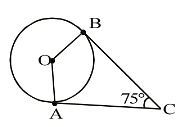
- a)75°
- b)85°
- c)95°
- d)105º
Correct answer is option 'D'. Can you explain this answer?
In fig, O is the centre of the circle, CA is tangent at A and CB is tangent at B drawn to the circle. If ∠ACB = 75°, then ∠AOB =
a)
75°
b)
85°
c)
95°
d)
105º
|
|
Kuldeep Kuldeep answered |
Solution:- The length of tangents drawn from an external point to the circle are equal.
In the figure, CA and CB are the tangents from external point of a circle and OA and OB are the two radius of a circle.
Draw a line OC, then you will get two triangles OAC and OBC.
In a ∆le AOC and ∆le BOC,
Angle OAC and OBC = 180 degree. Because, these are angles between the radii and tangents. So, there are two right angles.
The value for right angled triangle is 90 degree. Here, you can see both right angled triangle, so 90×2 = 180 degree.
Angle AOB = Angle OAC + Angle OBC - Angle ACB.
Given:- Angle ACB = 75 degree. , Angle OAC and OBC = 90 degree.
Angle AOB = 90 + 90 - 75.
Angle AOB = 180 -75.
Angle AOB =105 degree.
So, option d is correct friend.
In the figure, CA and CB are the tangents from external point of a circle and OA and OB are the two radius of a circle.
Draw a line OC, then you will get two triangles OAC and OBC.
In a ∆le AOC and ∆le BOC,
Angle OAC and OBC = 180 degree. Because, these are angles between the radii and tangents. So, there are two right angles.
The value for right angled triangle is 90 degree. Here, you can see both right angled triangle, so 90×2 = 180 degree.
Angle AOB = Angle OAC + Angle OBC - Angle ACB.
Given:- Angle ACB = 75 degree. , Angle OAC and OBC = 90 degree.
Angle AOB = 90 + 90 - 75.
Angle AOB = 180 -75.
Angle AOB =105 degree.
So, option d is correct friend.
Number of tangents, that can be drawn to a circle, parallel to a given chord is- a)3
- b)Zero
- c)Infinite
- d)2
Correct answer is option 'D'. Can you explain this answer?
Number of tangents, that can be drawn to a circle, parallel to a given chord is
a)
3
b)
Zero
c)
Infinite
d)
2
|
|
Gaurav Kumar answered |
There are only two tangents that can be drawn parallel to a given chord. That is the tangents are drawn on either side of the chord so that both are parallel to the chord.
From a point A, the length of a tangent to a circle is 8cm and distance of A from the circle is 10cm. The length of the diameter of the circle is
- a)6 cm
- b)12 cm
- c)16 cm
- d)14 cm
Correct answer is option 'B'. Can you explain this answer?
From a point A, the length of a tangent to a circle is 8cm and distance of A from the circle is 10cm. The length of the diameter of the circle is
a)
6 cm
b)
12 cm
c)
16 cm
d)
14 cm
|
|
Himaja Ammu answered |
Angle APO=90[radius is always perpendicular to the tangent)]
now by Pythagoras theorem AO^2=AP^2+OP^2
10^2=8^2+OP^2
OP^2=36
OP=6cm
here OP is nothing but the radius of circle
we know diameter is twice the radius...so
diameter=(2×6)=12 cm
now by Pythagoras theorem AO^2=AP^2+OP^2
10^2=8^2+OP^2
OP^2=36
OP=6cm
here OP is nothing but the radius of circle
we know diameter is twice the radius...so
diameter=(2×6)=12 cm
How many tangents can be drawn to a circle from a point in its interior?- a)One
- b)Two
- c)infinite
- d)None
Correct answer is option 'D'. Can you explain this answer?
How many tangents can be drawn to a circle from a point in its interior?
a)
One
b)
Two
c)
infinite
d)
None
|
|
Shiva Tiwari answered |
Tangent can only be drawn from outside.and from a point outside the circle only two tangent can be drawn
Two circles touch each other externally at C and AB is common tangent of circles, then ∠ACB is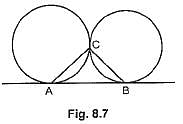
- a)70°
- b)60°
- c)100°
- d)90°
Correct answer is option 'D'. Can you explain this answer?
Two circles touch each other externally at C and AB is common tangent of circles, then ∠ACB is

a)
70°
b)
60°
c)
100°
d)
90°
|
|
Nirmal Kumar answered |
Option d is correct because we know that tangents drawn from an external point to a circle make 90 degree at the point of contact
In the given figure, point P is 26 cm away from the centre O of a circle and the length PT of the tangent drawn from P to the circle is 24 cm. Then the radius of the circle is
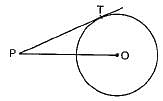
- a)25 cm
- b)26 cm
- c)24 cm
- d)10 cm
Correct answer is option 'D'. Can you explain this answer?
In the given figure, point P is 26 cm away from the centre O of a circle and the length PT of the tangent drawn from P to the circle is 24 cm. Then the radius of the circle is


a)
25 cm
b)
26 cm
c)
24 cm
d)
10 cm
|
|
Vikram Kapoor answered |

∵ OT is radius and PT is tangent
∴ OT ⊥ PT
Now, in ΔOTP,
OP2 = PT2 + OT2
⇒ 262 = 242 + OT2
⇒ 676 - 576 -OT2
⇒ 100 = OT2 ⇒ 10 cm = OT
In Fig. 8.4, the pair of tangents AP and AQ drawn from an external point A to a circle with centre O are perpendicular to each other and length of each tangent is 5 cm. Then radius of the circle is

- a)10 cm
- b)7.5 cm
- c)5 cm
- d)2.5 cm
Correct answer is option 'C'. Can you explain this answer?
In Fig. 8.4, the pair of tangents AP and AQ drawn from an external point A to a circle with centre O are perpendicular to each other and length of each tangent is 5 cm. Then radius of the circle is


a)
10 cm
b)
7.5 cm
c)
5 cm
d)
2.5 cm
|
|
Amana Akbar answered |
Construction
join op and oq
now
in quadrilateral opaq
angle apo=oqa(tangent and point of contact)
now adding all angles and subtracting from 360
we get
angle poq=90
we now observe that the quadrilateral is square
therefore oq=op=pa=AQ
it implies oq=op=5cm
and op and oq are radii
therefore radius =5cm
join op and oq
now
in quadrilateral opaq
angle apo=oqa(tangent and point of contact)
now adding all angles and subtracting from 360
we get
angle poq=90
we now observe that the quadrilateral is square
therefore oq=op=pa=AQ
it implies oq=op=5cm
and op and oq are radii
therefore radius =5cm
The quadrilateral formed by angle bisectors of a cyclic quadrilateral is a:- a)rectangle
- b)square
- c)parallelogram
- d)cyclic quadrilateral
Correct answer is option 'D'. Can you explain this answer?
The quadrilateral formed by angle bisectors of a cyclic quadrilateral is a:
a)
rectangle
b)
square
c)
parallelogram
d)
cyclic quadrilateral
|
|
Shubham Sharma answered |
To prove: PQRS is a cyclic quadrilateral.
Proof: In △ARB, we have
1/2∠A + 1/2∠B + ∠R = 180° ....(i) (Since, AR, BR are bisectors of ∠A and ∠B)
In △DPC, we have
1/2∠D + 1/2∠C + ∠P = 180° ....(ii) (Since, DP,CP are bisectors of ∠D and ∠C respectively)
Adding (i) and (ii),we get
1/2∠A + 1/2∠B + ∠R + 1/2∠D + 1/2∠C + ∠P = 180° + 180°
∠P + ∠R = 360° - 1/2(∠A + ∠B + ∠C + ∠D)
∠P + ∠R = 360° - 1/2 x 360° = 360° - 180°
⇒ ∠P + ∠R = 180°
As the sum of a pair of opposite angles of quadrilateral PQRS is 180°. Therefore, quadrilateral PQRS is cyclic.
AB and CD are two common tangents to circles which touch each other at C. If D lies on AB such that CD = 4 cm, then AB is equal to
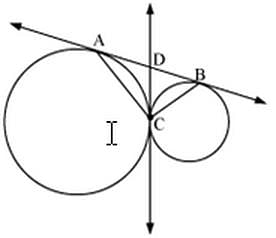
- a)4 cm
- b)6 cm
- c)8 cm
- d)12 cm
Correct answer is option 'C'. Can you explain this answer?
AB and CD are two common tangents to circles which touch each other at C. If D lies on AB such that CD = 4 cm, then AB is equal to


a)
4 cm
b)
6 cm
c)
8 cm
d)
12 cm
|
|
Amit Kumar answered |
From the given figure, CD = 4 cm
CD=AD=4CD = AD = 4CD=AD=4 (tangents drawn from an exterior point are equal)
CD=BD=4CD = BD = 4CD=BD=4 (tangents drawn from an exterior point are equal)
Now, AB=AD+BD=4+4=8AB = AD + BD = 4 + 4 = 8AB=AD+BD=4+4=8 cm
CD=AD=4CD = AD = 4CD=AD=4 (tangents drawn from an exterior point are equal)
CD=BD=4CD = BD = 4CD=BD=4 (tangents drawn from an exterior point are equal)
Now, AB=AD+BD=4+4=8AB = AD + BD = 4 + 4 = 8AB=AD+BD=4+4=8 cm
Chapter doubts & questions for Circles - Mathematics for Year 10 2024 is part of Year 10 exam preparation. The chapters have been prepared according to the Year 10 exam syllabus. The Chapter doubts & questions, notes, tests & MCQs are made for Year 10 2024 Exam. Find important definitions, questions, notes, meanings, examples, exercises, MCQs and online tests here.
Chapter doubts & questions of Circles - Mathematics for Year 10 in English & Hindi are available as part of Year 10 exam.
Download more important topics, notes, lectures and mock test series for Year 10 Exam by signing up for free.
Mathematics for Year 10
101 videos|327 docs|113 tests
|
Signup to see your scores go up within 7 days!
Study with 1000+ FREE Docs, Videos & Tests
10M+ students study on EduRev
|
Free Exam Preparation
at your Fingertips!
Access Free Study Material - Test Series, Structured Courses, Free Videos & Study Notes and Prepare for Your Exam With Ease

 Join the 10M+ students on EduRev
Join the 10M+ students on EduRev
|

|
Forgot Password
OR
Signup to see your scores
go up within 7 days!
Access 1000+ FREE Docs, Videos and Tests
Takes less than 10 seconds to signup

